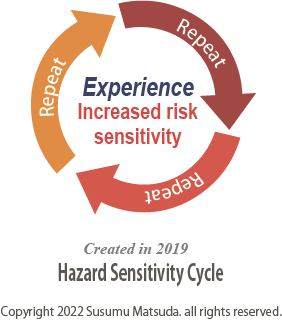It has been confirmed that the risk susceptibility to disasters is lost after a large number of days have passed since the occurrence of the disaster. This is an obstacle for companies to continue their social activities. Decreased risk sensitivity in corporate workplaces, manufacturing plants, manufacturing plants, and various social activities is a major social problem. In response to occupational accidents, companies regularly provide safety education to working personnel. Until now, safety education has focused on classroom learning using past disaster cases, and group education is the current situation. The biggest issue in classroom-based education is that while the quality of education is high, it is difficult to keep students focused on education. In recent years, safety education that simulates disasters with simple machines has appeared, but at the same time it is difficult to increase the variation of disasters, people have learned the mechanism to simulate the experience, and in the second and subsequent education. It has been pointed out that it is difficult to produce an educational effect. On the other hand, it is relatively easy to increase the variation of disaster experience using VR by combining the type of work environment and the type of disaster occurrence.

Therefore, it is possible to convey the fear of a disaster by using it over and over again every six months to one year while switching between abundant disaster variations. It has also been found that the simulated experience of disasters, which is limited to seeing and hearing, does not convey fear to people, and there is a mechanism to experience the five senses including the sense of touch and a mechanism for education that does not make disasters other people’s affairs. Is required. For that purpose, we will realize safety education by combining the experience according to the experience person’s workplace environment and the mechanism to reproduce the disaster that can actually occur in the experience person’s workplace. It has been confirmed that the disaster experience, including the tactile sensation, which is the main sense of the disaster, effectively conveys the fear. There are many types of tactile sensations that can be reproduced, such as touching sensations, painful sensations, forceful compressions, and pulling sensations. In addition, the sensation to be reproduced needs to be optimized for each disaster, and the sensation must be selected appropriately. For these pseudo-reproductions using the device, it is necessary to prepare multiple reproduction units according to the type of disaster. By experiencing these things, you can convey the fear of experiencing a disaster and increase your sensitivity to danger. However, due to the characteristics of human beings, it has been found that human risk susceptibility gradually decreases with the passage of time. This is a forgetting function that is provided to maintain the life of a person, including the mental aspect. Therefore, on the premise that memory and sensitivity are gradually lost, it is necessary to respond according to the characteristics of the person. Sensitivity generally declines significantly after six months to a year, and as the decline progresses, susceptibility is almost lost, and the risk of disasters increases again. Therefore, before the danger susceptibility is lost and it enters the danger zone, the disaster susceptibility is maintained by performing the disaster experience again with VR. By repeating this after a certain period of time, it is possible to prevent the risk sensitivity from decreasing. At the same time, it is important to carry out education to raise the level of safety awareness itself by using disaster case studies and actual disaster experiences (visually observing physical phenomena such as crushing and damage) using mechanical experience machines.
No tags for this post.